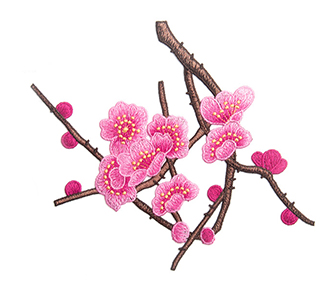Summary:Before purchasing an embroidery machine for production, users have to make a lot of preparations, such as purchasing emb...
Before purchasing an embroidery machine for production, users have to make a lot of preparations, such as purchasing embroidery accessories, of which embroidery thread is a very important part.
Embroidery threads of different computer embroidery machines have very different textures. Before production, we must first understand the applicability of embroidery thread for different fabrics and customer requirements. To avoid mismatches, let’s analyze the characteristics of several common embroidery threads.
1. Polyester yarn
The characteristic of polyester yarn is that it can withstand chemicals and wash frequently to reduce the fading and discoloration of clothes. Therefore, hotel uniforms, stone blue denim clothing, sportswear or children's clothing are all made of polyester yarn.
In order to prevent the phenomenon of washing and fading to the maximum extent.
In contrast, polyester yarn is tougher than rayon.
When embroidering, the machine is running at high speed, and the high tenacity polyester yarn can also withstand greater tension; therefore, it is often used for three-dimensional embroidery, hat pieces, shoe pieces, and embroidery on hard embroidery materials such as handbags. Moreover, its fire resistance is high, even if the clothing is close to the flame, it is not easy to touch the fire.
The thread quality of polyester yarn is not more stable than that of rayon, but more elastic.
You can cut a piece of rayon thread for a test, pull it hard, and then relax, you will find that the embroidery thread will not shrink much; on the contrary, once the polyester thread is stretched, once it is relaxed, it will return to its original length, which may cause the flower to wrinkle , So the online tension training needs to be more accurate.
2. Rayon
The properties of rayon and polyester yarn are similar.
In addition, as mentioned above, the stability of rayon is higher than that of polyester yarn. Even if it is pulled by the machine frame, it will not shrink significantly, but it is easy to catch fire and is not suitable for frequent washing.
3. Metal wire
The characteristic of metal wire is that the outer layer of the line is covered with a metal film, and the inner layer is actually composed of rayon or polyester yarn.
Because of the surface luster of the thread, the designer can make a glittering embroidery effect; but at the same time, it also has a negative impact on embroidery.
Because when embroidering, the embroidery needles, embroidery threads and fabrics often rub against each other to generate heat. At this time, the young hairs of the embroidery thread play a role to take the heat away through the embroidery needles, and the surface of the metal wire does not have young hairs. The heat of the embroidery needle still exists, so that the metal film is dissolved by the heat, and even the thread is broken.
 4. Wool thread
4. Wool threadWool thread is thicker than ordinary embroidery thread, and it is a different kind of embroidery thread.
It is most commonly used in towel embroidery, rope embroidery and chain stitching. It is especially beautiful when paired with knitted fabrics, especially for girls' knitted garments, with soft embroidery effects and more handicraft beauty.
Because of its thick body texture, thicker needles need to be used, 100 gauge or 110 gauge needle is suitable, but it must be considered whether it can match the fabric.
In addition, the thread tension should be relatively loosened to provide enough space for the embroidery thread to move.
5. Abnormity lineThe special-shaped thread has strong tension and is not easy to break. The effect is similar to that of polyester thread. It is mostly used by embroidery factories.
Disadvantages: it feels hard when used as a pattern with multiple stitches.


